Hard to believe we have almost hit 100 issues of this newsletter. I’m cooking up a fun promotion for next week when we break into triple digits. In the meantime, I hope you enjoy this rather long journey into my fried rice mind. Don’t be put off by its length. I’m just trying to give you all the information you need to make fried rice yourself without a recipe, the way I do at home on a regular basis. Enjoy. —Mitchell
Considering I probably make fried rice about once a week, it’s hard for me to believe I haven’t already written about it for this newsletter. To be sure, I scanned the previous issues a couple of times. And then once I started writing and thoughts began rattling around in my head that seemed familiar, I scanned them again to double check. Monday night, I tested my recipe and served fried rice for dinner. When I mentioned to Nate that I was writing about fried rice this week, he too couldn’t believe I hadn’t done it already. So, he scanned the backlist himself, as well. Nope.
Which brings me to this week’s topic, fried rice.
I’ve been making fried rice pretty regularly for more than three decades. During that time my approach has evolved. More a technique than a recipe, I decide to make fried rice when I have a critical mass of bits and bobs to use up in the fridge, key among them, rice of course. But usually, it’s not the rice, it’s the combination of everything else that moves me to get out the wok.
Any culture for which rice is a primary staple has many ways to use up leftovers. Among Asian cultures—Chinese, Thai, Korean, Vietnamese—fried rice reigns supreme. My technique is a combination of all of the above, depending on what I have to use. Before I provide you with a recipe, I thought I’d walk you through my thought process so you understand the fundamentals at work. Truth is, I never use a recipe and eventually neither should you.
Cooking Vessel
I almost always make my fried rice in a wok, which has the right shape and surface area to allow you to evenly cook, toss, and distribute all the ingredients for a decent-sized batch of rice. But a large frying pan also works fine. The bigger the better.
Timing
As with most Asian high-heat cooking, it’s best to have all of your fried rice ingredients prepped and ready to cook before you begin. Chop vegetables. Bone and dice meat. Soak dried mushrooms, if using. Mince herbs. Measure out ingredients for the sauce. Once you heat up the pan, finishing the rice won’t take long.
There are two key phases in fried rice cooking: before the rice is added and after. Things that require extended cooking need to be added before the rice. This includes alliums, such as onions or leeks, raw proteins, and long-cooking vegetables, such as carrots or cabbage. In order to avoid overcooking proteins that aren’t cooked already, especially chicken and seafood, but also eggs, it’s best to cook them first and then remove them from the wok before you proceed with the rice. Wipe out the wok, continue making the fired rice, and add them back toward the end of cooking, just to warm up
Things that are already cooked and/or just need to be heated up should be added after the rice is in.
Rice
At our home, leftover rice is almost always destined for fried rice. In fact, if I’m making rice for anything, I make extra to have leftover to fry at another time. If I eat Chinese food out, I bring the leftover rice home to fry. I use Chinese, Japanese, Thai jasmine, even basmati rice, both white and brown. I particularly like using brown rice for fried rice as I think the texture and flavor are well suited, but any will do. Sometimes I mix rices, too.
As Thai food aficionado Derek Lucci of @makebistro likes to point out, you can make fried rice with freshly cooked rice perfectly well, as long as it isn’t mush (which it shouldn’t be if you’ve cooked it properly).
A food-poisoning scare about using leftover rice has resurfaced thanks to TikTok. The culprit, a bacteria known as Bacillus cereus, is common on all grains and is only an issue if the grains are improperly handled. Let rice cool completely before refrigerating and reheat it thoroughly before eating and all should be well. For more info, check out this Bon Appetit post.
Fat
I usually use peanut oil, but you can use any other vegetable oil. Rendered animal fat—such as lard, duck, or bacon fat—makes a particular tasty fried rice. Sometimes, if I have leftover roast duck or soy sauce chicken, I’ll dice the skin and add it to the pan first to both season the pan and to render any remaining fat.
Alliums and Aromatics
I always start with a collection of alliums and aromatics, such as onions, leeks, shallots, garlic, garlic chives, flowering chives, garlic scapes and/or ramps, in season (i.e., NOW!), that I cook in the fat until soft. Don’t let them burn. (Scallions are a must in fried rice, but they go in at the end.) To these, I usually add ginger and sometimes minced fresh lemongrass, and/or some minced hot pepper, if I have it. A spoonful of XO sauce at this point adds a boost of umami.
Vegetables
I like a lot of vegetables in my fried rice. The key is to cut them all into small dice so that they cook quickly and disperse evenly among the grains of rice, giving the finished rice an attractive, almost bejeweled quality. I use celery and/or celery root, carrots, cabbage, bok choy or other Asian greens, turnips, broccoli, cauliflower, fennel, and/or mushrooms, fresh or dried (and rehydrated). You can also use cooked vegetables, especially from leftover Chinese food, again, diced fine, but as with anything already cooked, add these at the end, after the rice is added. Peas are de rigueur in fried rice. I always have a bag of peas in the freezer expressly for making it. I let the peas defrost before I add them toward the end, after the rice.
Kimchi and other fermented vegetables, such as Sichuan yacai or spicy preserved radish, are a great addition, too. Dice them up. The older and funkier the kimchi, the better. Sauté it with the aromatics before you add the rice so it takes on a pleasant cooked, almost caramelized flavor.
Proteins
I like to used cooked meat, finely diced, especially roasted Chinese meats, such as pork or duck or soy sauce chicken, skin included (see above). Ham works well, too. So does leftover steak. As already noted, if using raw meat, such as ground pork, chicken or beef, diced bacon, sausage, or other stuff, it’s best to season it with some soy, cooking wine, salt, and pepper and cook it at the beginning, remove it from the pan, and then add it back at the end. Add the cooked meat after the rice to heat through. Seafood is great in fried rice, too. Same rules apply. Flake cooked fish or crab, dice cooked lobster or shrimp, and add them at the end.
Like peas, eggs are pretty standard in fried rice. But as I already eat too many eggs from my cardiologist’s point of view, I don’t always add them. If I do, I often use up leftover egg wash from baking or egg whites from Nate’s ice cream factory. Or else one or two whole eggs will do the trick. Beat them in a small bowl and season them with salt and white pepper. Cook them in a very hot wok or pan with a little oil to make a very thin omelet. Remove from the pan and cut or tear into small bits. Clean out the work or pan and continue with the recipe. A sunny-side-up fried egg is a traditional garnish on top of kimchi fried rice and a few other variations, as well. Go for it.
For tofu, my preference is to used pressed or fried, the texture of which holds up better in the finished rice than other varieties. Dice it and add it toward the end.
Seasonings
Over the years I’ve pulled back on the seasoning of my fried rice, and of my Chinese food in general. I used to think that in order to get the restaurant flavor I was looking for in my Chinese cooking, I needed to amp up the condiments. But I’ve come to realize what I actually needed to do was pull back, increase the wok hey (that almost-smoky flavor that comes from high-heat wok cooking), find ways to enhance umami (I avoid MSG), and let the other flavors come out. These days, I rely on a basic combination of soy sauce, Shoaxing cooking wine, sesame oil, and Thai fish sauce, but not too much.
One mistake I used to make with Chinese food was assuming that the salt from the various sauces was enough to season the entire dish. In fact, I’ve come to realize you need a little more. Add a pinch every time you add something to the wok to season the rice properly. White pepper is also a welcome addition.
Herbs and Garnishes
I always finish my fried rice with a handful of chopped scallions, perhaps some chopped cilantro or Thai basil or shiso. Some toasted peanuts or sesame seeds can also be nice. Hold back a little of each to garnish the top of the rice when you serve it.
Other Tips
If the rice is cold, you add it to the wok or pan in a big lump and press it with the back of a large spoon as it heats to break it up and until the grains separate. Keep mixing everything so the ingredients don’t burn.
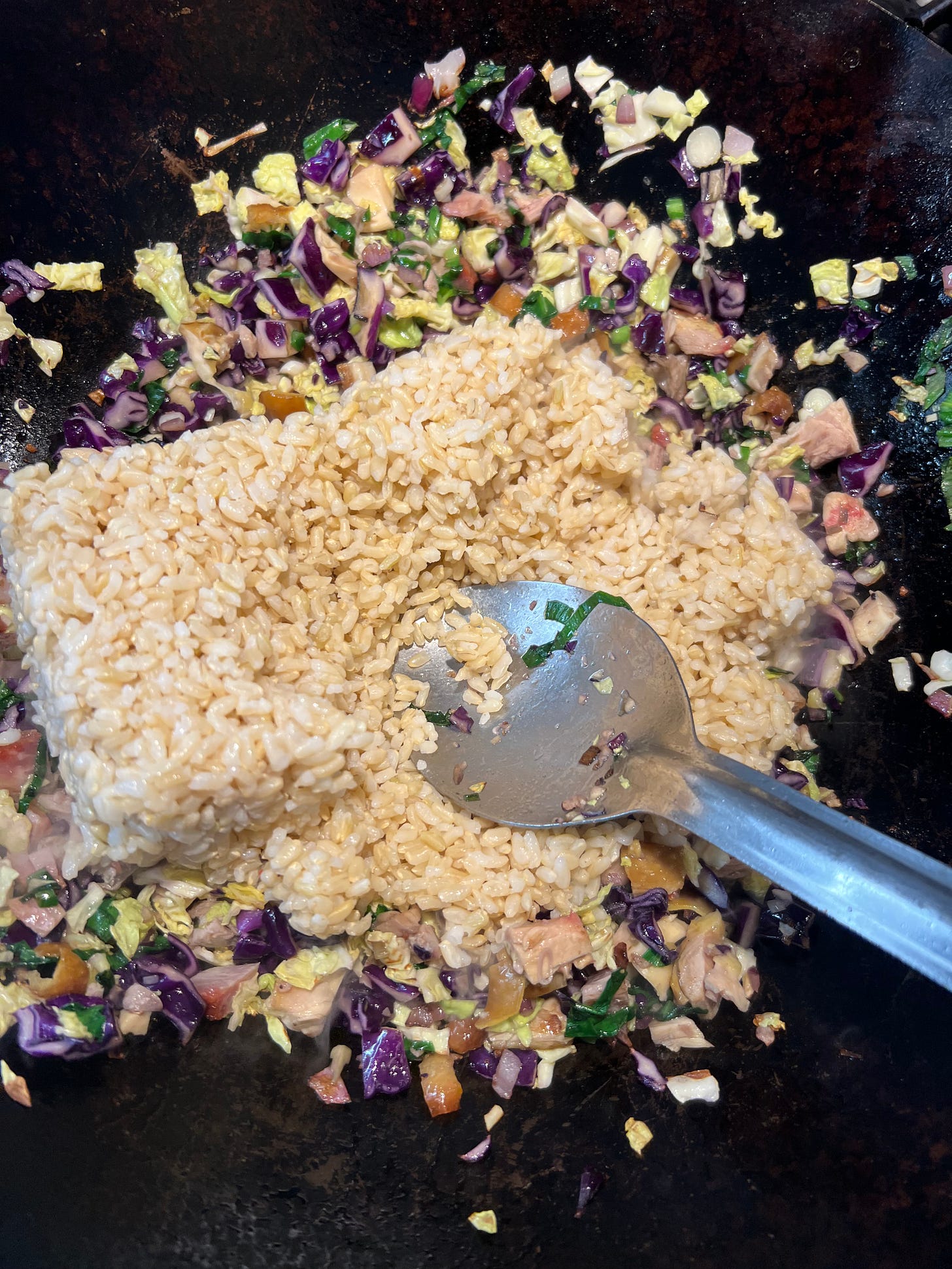
As cooked rice starts to heat up, it releases starch and can start to stick. I like to scrape off any crispy bits from the bottom of the wok or pan and stir them in. If the rice is dry, it can also stick. To help loosen it up, you can dribble in some stock or water to moisten the rice and scrape it from the pan. Once the rice is done, turn it off, cover the pan, and let it sit and steam for a minute or so, and the rice will also magically loosen from the pan.
RECIPE: Mitchell’s Fried Rice
(Makes up to 8 servings, depending on what else you are serving, but Nate and I usually eat this entire thing ourselves for dinner.)
For the seasoning
2 tablespoons light soy sauce
2 tablespoons Shaoxing cooking wine
1 teaspoon toasted sesame oil
1 tablespoon Thai fish sauce (optional)
For the fried rice
1 or 2 egg(s), beaten (optional)
Salt
Freshly ground white pepper
2 or 3 tablespoons peanut or other oil, or rendered animal fat, or a combination
½ to ¾ cup chopped onion, leek, garlic chives, flowering chives, and/or other alliums
1 or 2 cloves garlic, minced
1 tablespoon or so minced ginger and/or fresh lemongrass
1 small hot pepper, seeded and minced (optional)
2 to 3 cups finely diced vegetables, such as celery, carrot, mushrooms, cabbage, turnip, bok choy, kimchi, or anything else you fancy, alone or in combination
2 to 3 cups cooked rice
½ to 1 cup diced, cooked protein, such as roast pork, duck, chicken, ham, shrimp, crab, fish, or pressed or fried tofu
½ cup or so frozen peas, defrosted
1 or 2 scallions, chopped
¼ cup chopped herbs, such as cilantro, Thai basil, or shiso
Toasted, chopped peanuts and/or sesame seeds, for garnish (optional)
In a small bowl, beat together the soy sauce, cooking wine, sesame oil, and fish sauce, if using. Set aside. (Note, nowadays I just pour these directly from the bottle into the pan.)
Beat the egg, if using, with a pinch of salt and some freshly ground white pepper. Heat the wok or frying pan over high heat. Add a tablespoon of oil, swirl around in the pan, and add the beaten egg and swirl the pan so it coats in thin layer. Pull the edges in toward the center to cook thoroughly. When set, scrape the omelet out onto a clean cutting board or plate. Break up into small bits and set aside. Wipe out the pan.
To finish the rice, add the remaining 2 tablespoons or so of oil or other fat into the hot wok or pan. Add the chopped onion and/or other alliums and cook for a couple of minutes until soft. Add the garlic, ginger, and any other aromatics, such as lemongrass and hot pepper, if using, and cook another minute or two. Add the vegetables and a pinch of salt and cook, tossing constantly, until they begin to soften. Once they are almost cooked through, add the rice.
Using the back of large spoon, press any lumps of rice firmly against the bottom of the pan to break them up into grains. Keep stirring the whole mixture to avoid burning while you smash the rice. Once the rice is broken up and heated through and the other ingredients are well distributed throughout, add the cooked protein and the peas. Give the seasoning sauces a stir and drizzle around the pan, constantly stirring and tossing to distribute. If the rice has started to stick badly to the pan, you can drizzle in some stock or water to loosen it. When everything is nicely colored by the sauces, evenly distributed, and warmed through, add the bits of egg back to the pan along with most the of the chopped scallion and chopped herbs. Toss again to distribute. Turn off the heat. Cover and let steam for a few minutes before serving. Transfer to a nice platter, garnish with any remaining scallion and the peanuts or sesame, if using, and serve.
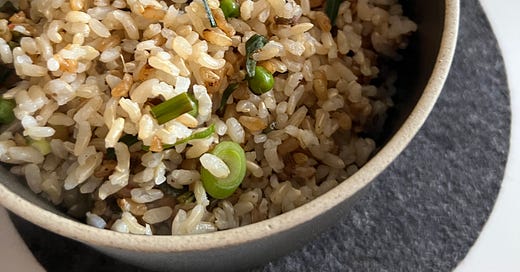


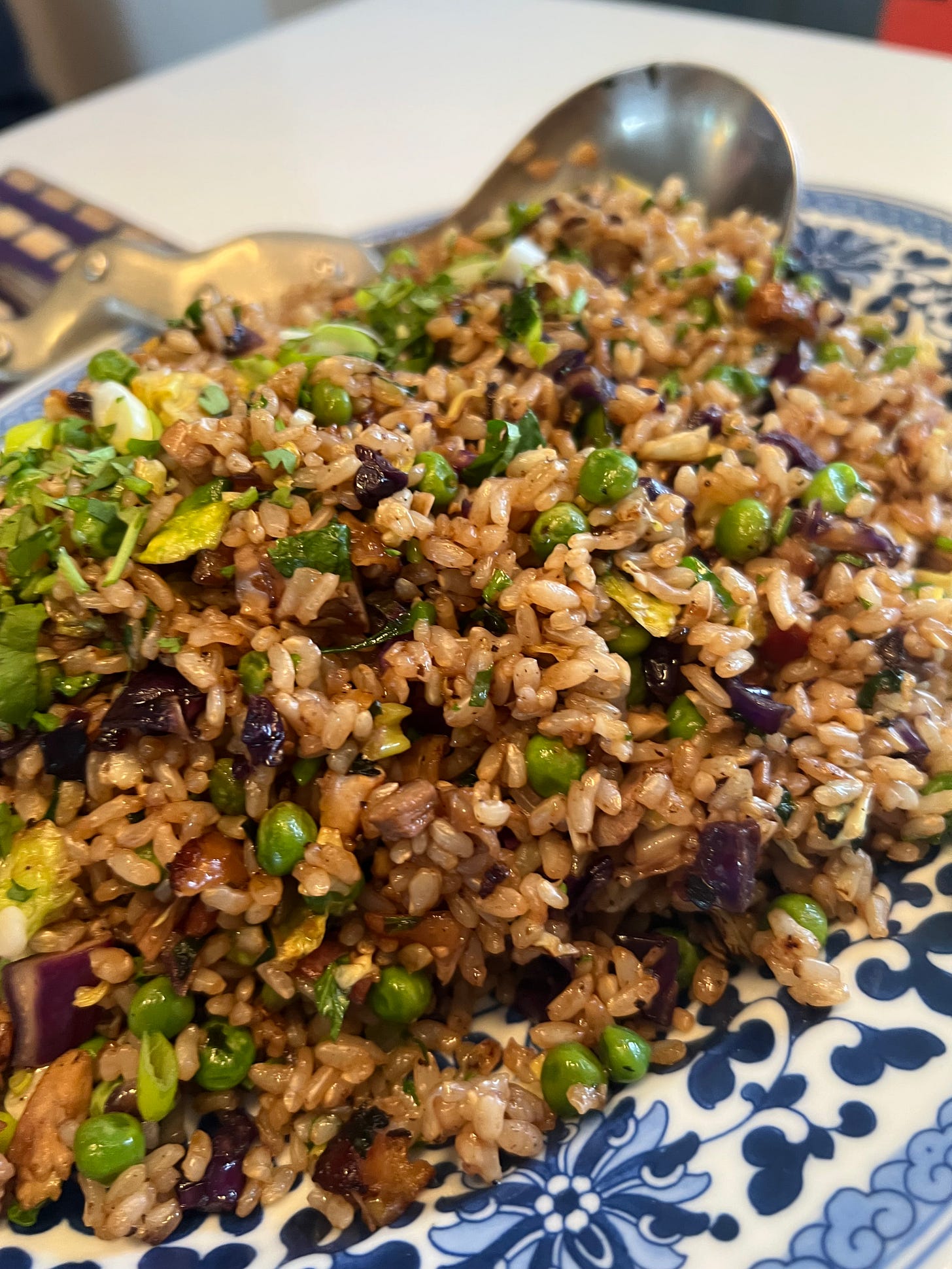
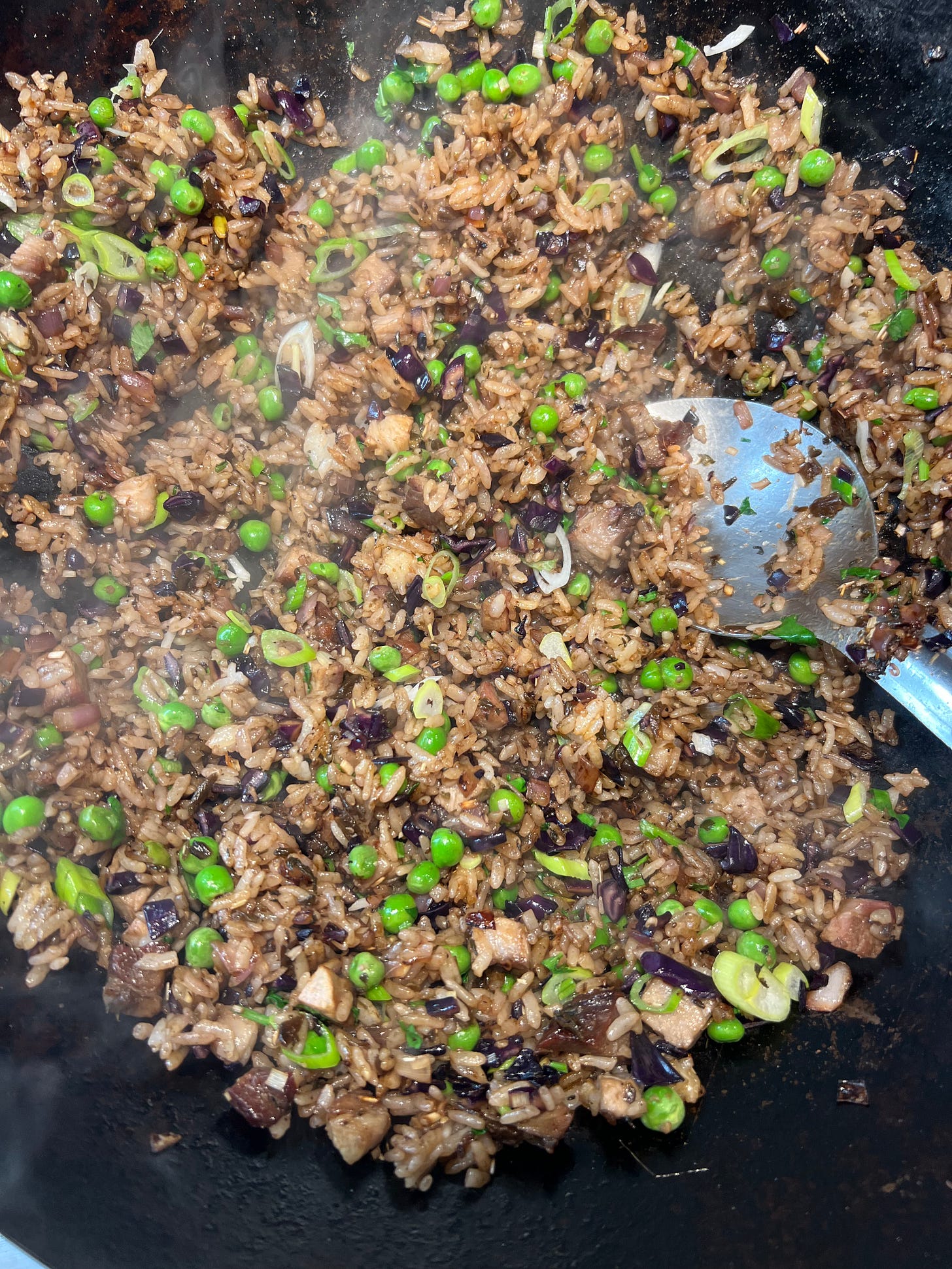
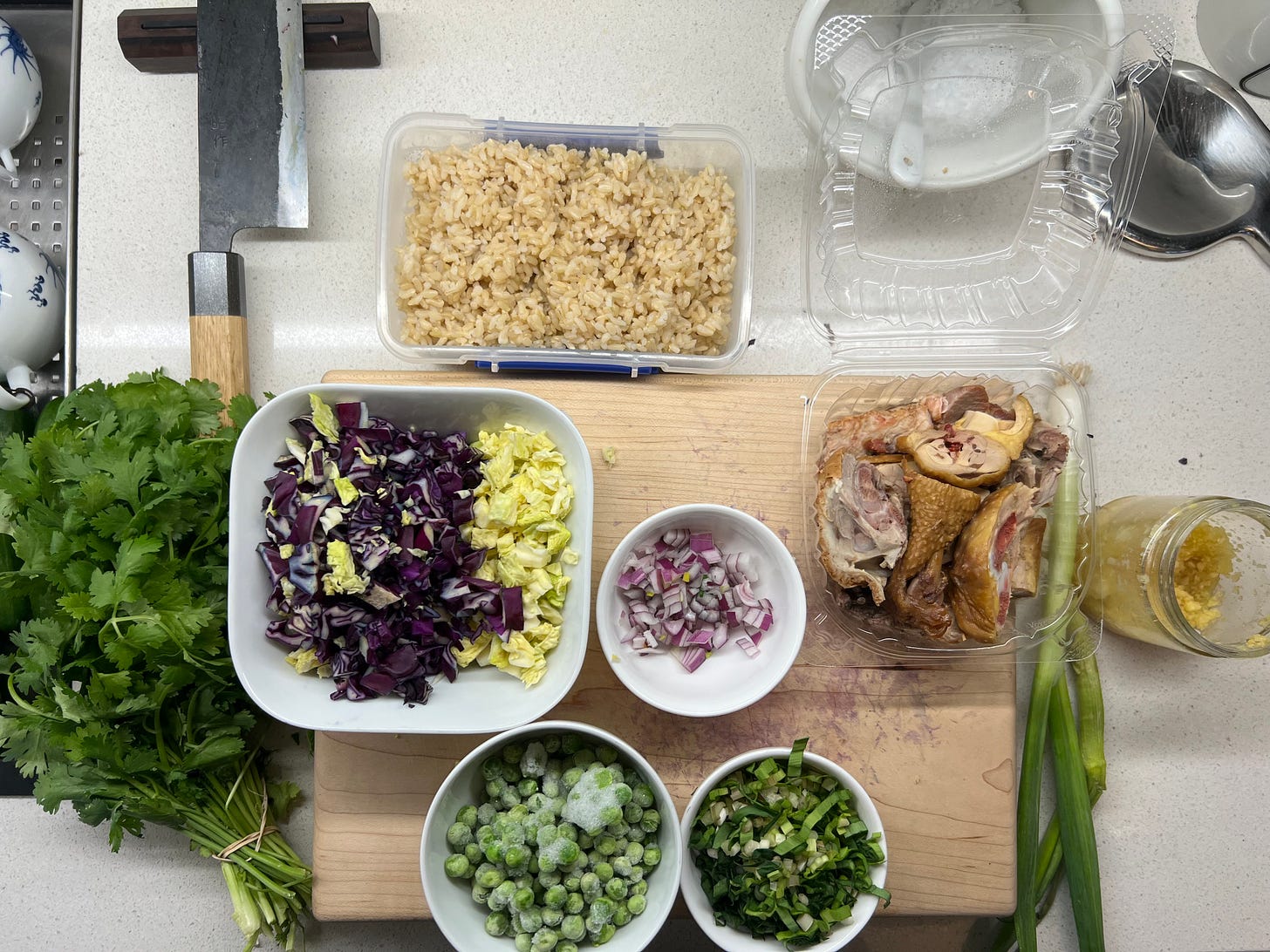
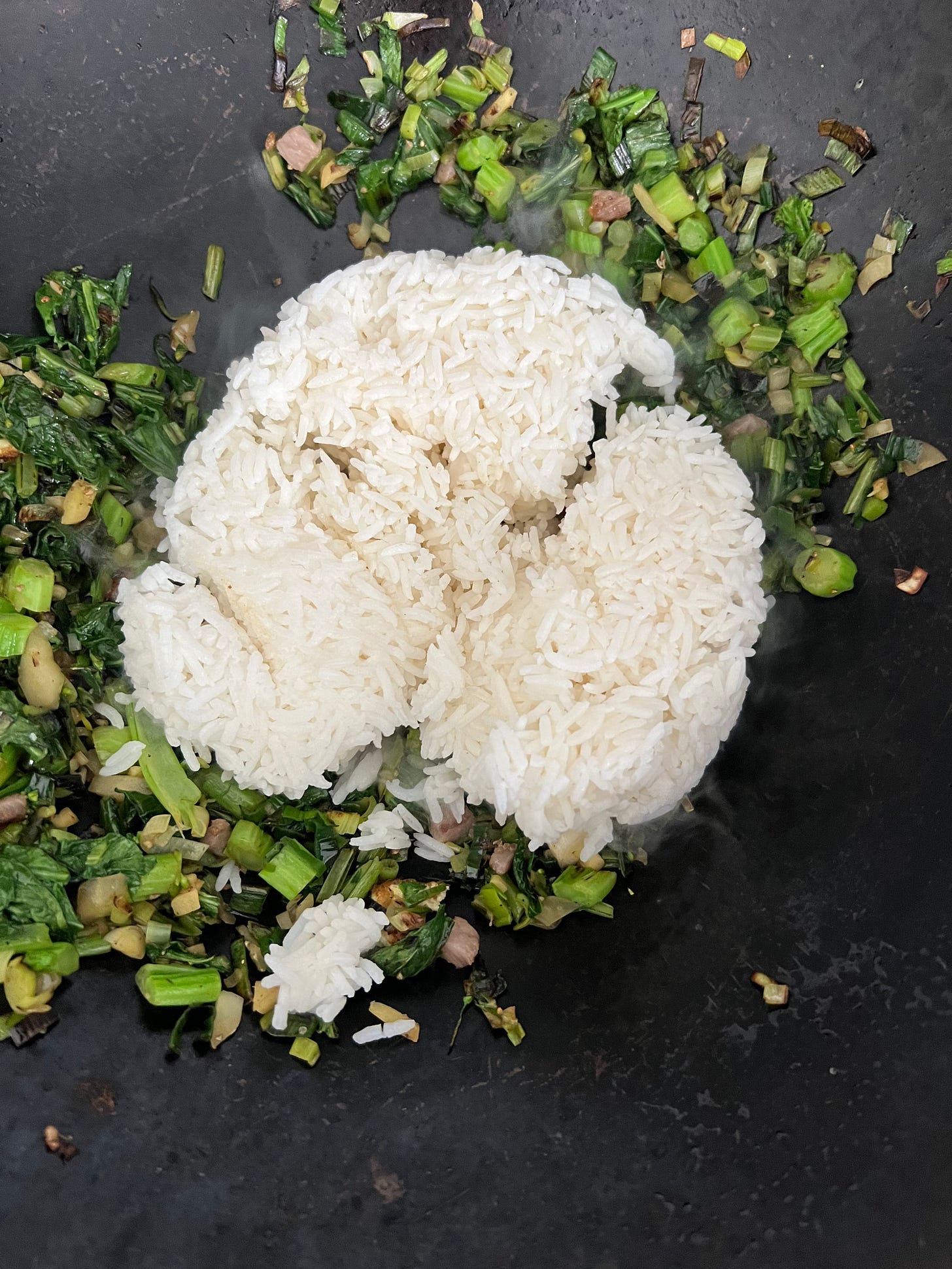
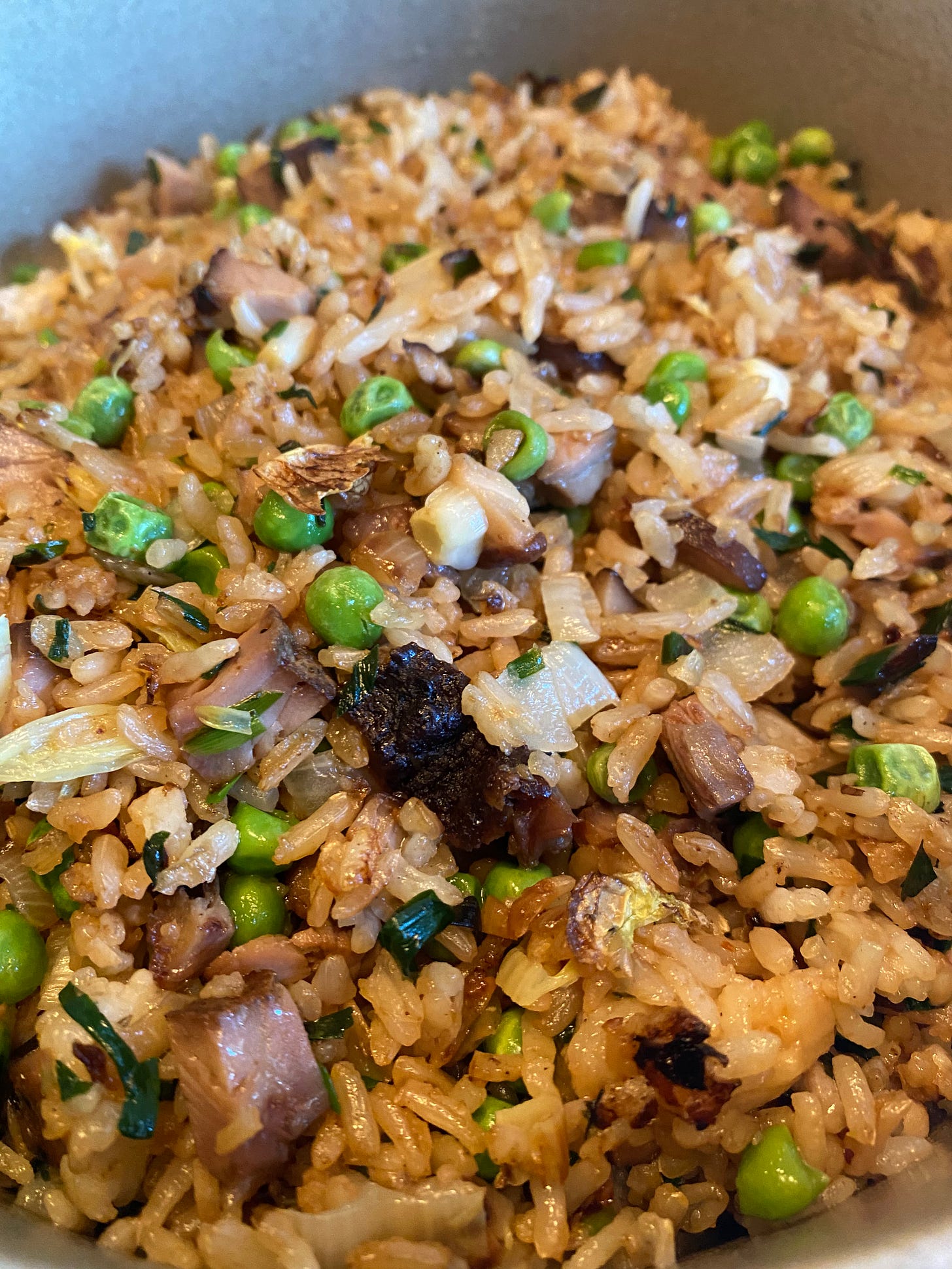
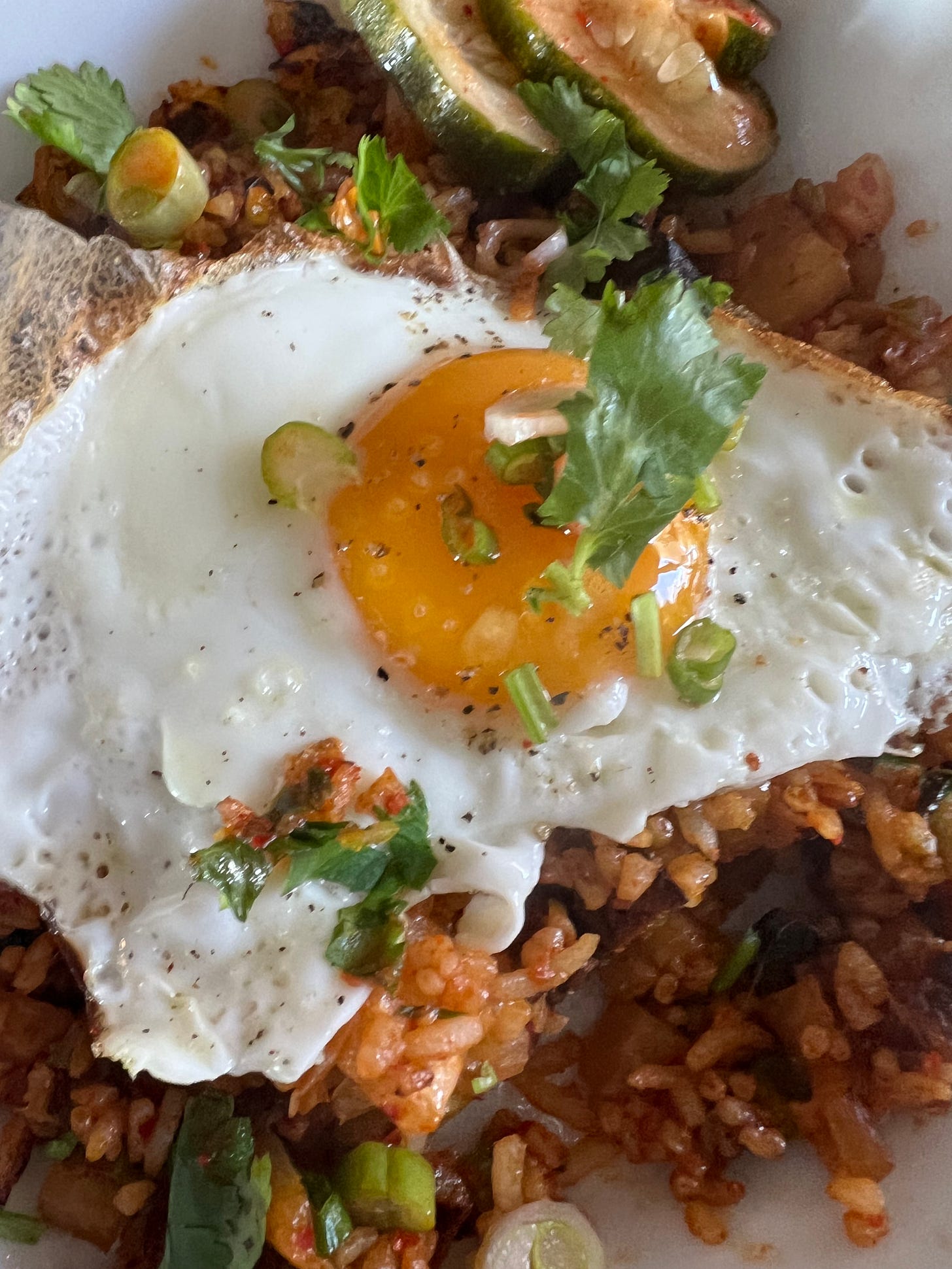

Any recs for a Wok?